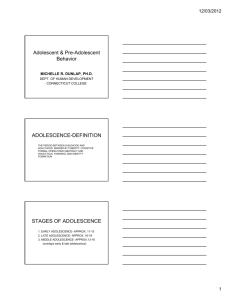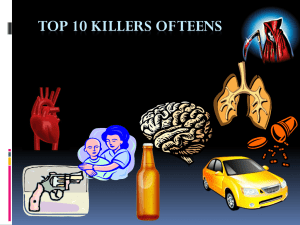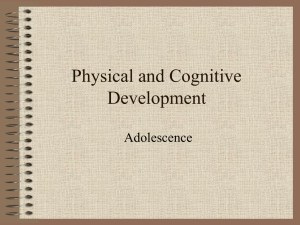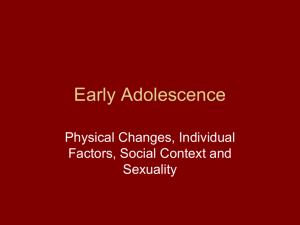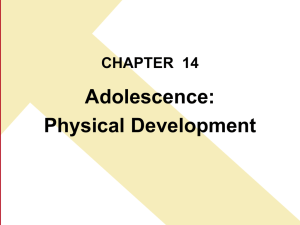Early Adolescence - Years Twelve to Fourteen
advertisement
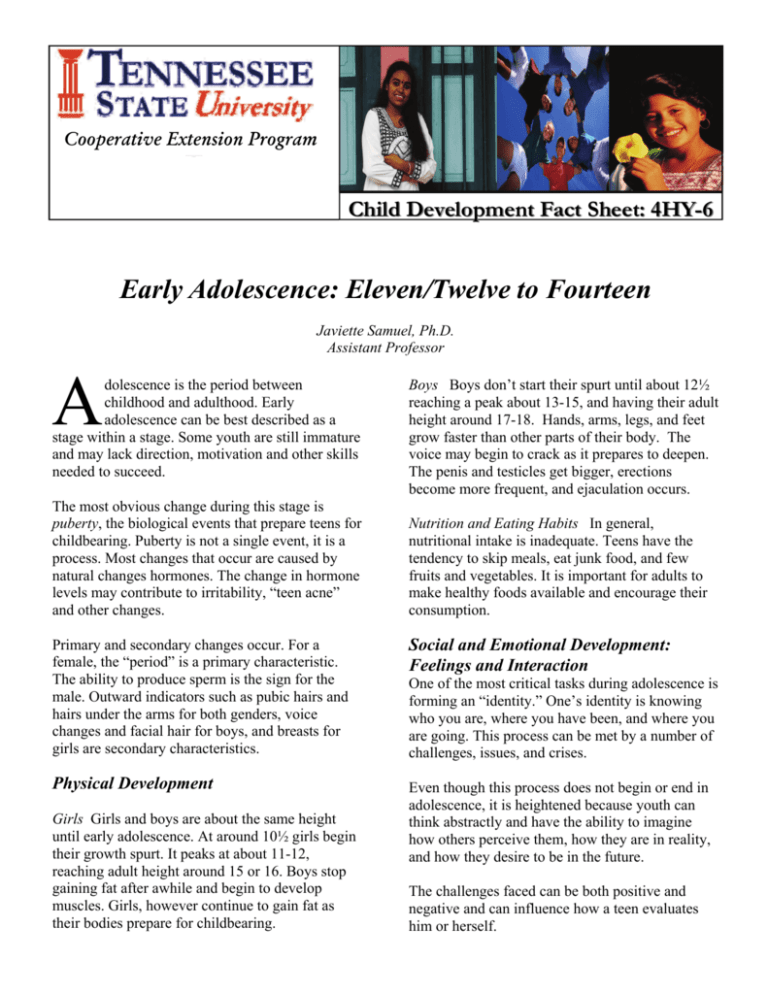
Child Development FACT SHEET 4HY-3 Cooperative Extension Program An Out reach E duc ation Program S ervi ng Limited Resource I ndividuals, Families and Comm unities Child Development Fact Sheet: 4HY-6 Early Adolescence: Eleven/Twelve to Fourteen Javiette Samuel, Ph.D. Assistant Professor A dolescence is the period between childhood and adulthood. Early adolescence can be best described as a stage within a stage. Some youth are still immature and may lack direction, motivation and other skills needed to succeed. The most obvious change during this stage is puberty, the biological events that prepare teens for childbearing. Puberty is not a single event, it is a process. Most changes that occur are caused by natural changes hormones. The change in hormone levels may contribute to irritability, “teen acne” and other changes. Boys Boys don’t start their spurt until about 12½ reaching a peak about 13-15, and having their adult height around 17-18. Hands, arms, legs, and feet grow faster than other parts of their body. The voice may begin to crack as it prepares to deepen. The penis and testicles get bigger, erections become more frequent, and ejaculation occurs. Nutrition and Eating Habits In general, nutritional intake is inadequate. Teens have the tendency to skip meals, eat junk food, and few fruits and vegetables. It is important for adults to make healthy foods available and encourage their consumption. Primary and secondary changes occur. For a female, the “period” is a primary characteristic. The ability to produce sperm is the sign for the male. Outward indicators such as pubic hairs and hairs under the arms for both genders, voice changes and facial hair for boys, and breasts for girls are secondary characteristics. Social and Emotional Development: Feelings and Interaction Physical Development Even though this process does not begin or end in adolescence, it is heightened because youth can think abstractly and have the ability to imagine how others perceive them, how they are in reality, and how they desire to be in the future. Girls Girls and boys are about the same height until early adolescence. At around 10½ girls begin their growth spurt. It peaks at about 11-12, reaching adult height around 15 or 16. Boys stop gaining fat after awhile and begin to develop muscles. Girls, however continue to gain fat as their bodies prepare for childbearing. One of the most critical tasks during adolescence is forming an “identity.” One’s identity is knowing who you are, where you have been, and where you are going. This process can be met by a number of challenges, issues, and crises. The challenges faced can be both positive and negative and can influence how a teen evaluates him or herself. If issues are not resolved during this time, they can carry into adulthood. Teens spend a great deal of time with their friends and less time with their family. Contrary to popular belief, research has found that, most teens do not “pressure” friends into such this as drugs, promiscuity, and skipping school. Rather than spending large amounts of time with peers of the same gender as evidenced during early childhood, teens begin to spend a significant amount of time interacting with peers of the opposite sex. They may talk on the phone a lot and require privacy to do so. They can sometimes be come frustrated or angry if they feel this privacy is violated. Cognitive Development: Reasoning and Problem Solving During early adolescence, youth develop a capacity for abstract, scientific thinking. Teens no longer need concrete examples to understand concepts and ideas. They can now complete high order math problems and understand other abstract concepts such as love and justice. Teens can be very egocentric. Egocentrism is the belief that one’s own perspective is shared by others. Two egocentric thought processes are very common. They are the personal fable and imaginary audience. The personal fable or a sense of invincibility and/ or the belief that an individual’s situation is unique is common. For example, a young lady may know girls in their school that are teen mothers yet may still have unprotected sex saying, “It won’t happen to me.” Feeling invincible is the cornerstone of this egocentric thought process. This Child Development Fact Sheet is part of a series prepared by the Cooperative Extension Program at Tennessee State University. For more information, contact your local county Agricultural Extension agent (See your telephone blue pages). Printable copies of this fact sheet can be found on our website. WE’RE ON THE WEB! HTTP://WWW.TNSTATE.EDU/CEP Quick Facts • Girls mature about two years earlier than boys. • Even though the exact trigger for puberty is not known, it occurs because of the release of hormones. • Boys that are “early bloomers” have greater social status. Girls that mature early, frequently feel uncomfortable. • Most teens feel as if their thoughts and ideas are unique. Such comments as “You would never understand!” are typical. • Teens are beginning to establish their identity. • Contrary to popular belief, for the most part, conflict between teens and parents is infrequent. • Friendships become more intimate. A sense of loyalty is expected since secrets, personal thoughts and beliefs are frequently shared. • It is rare for friends to encourage friends to engage in negative behavior (i.e. skipping school, trying alcohol or drugs). Peer influence is very important. Areas heavily influenced by peers include where to hang out, what to wear and how to dress. In fact, many teens may appear obsessed with their physical appearance. The idea that “everyone is looking at me” is characteristic of a concept called the imaginary audience. References Berk, L. (1999). Infants, Children & Adolescents. Third Edition. Allyn and Bacon Fabes, R., Martin C.L. (2003). Exploring Child Development. Second Edition. Allyn and Bacon Educating People for Better Living TSU-05-005(A)-7e-533224 The Cooperative Extension Program offers its programs to all persons regardless of race, color, age, national origin, gender or disability and is an Equal Opportunity employer. The Extension Service and the U.S. Department of Agriculture cooperating.. Printed by: DocuTech Printing Service Tennessee State University Cooperative Extension Program 3500 John A. Merritt Blvd., Box 9635 Nashville, TN 37209-1561 615-963-7885 Clyde E. Chesney, Administrator Latif Lighari, Associate Administrator





